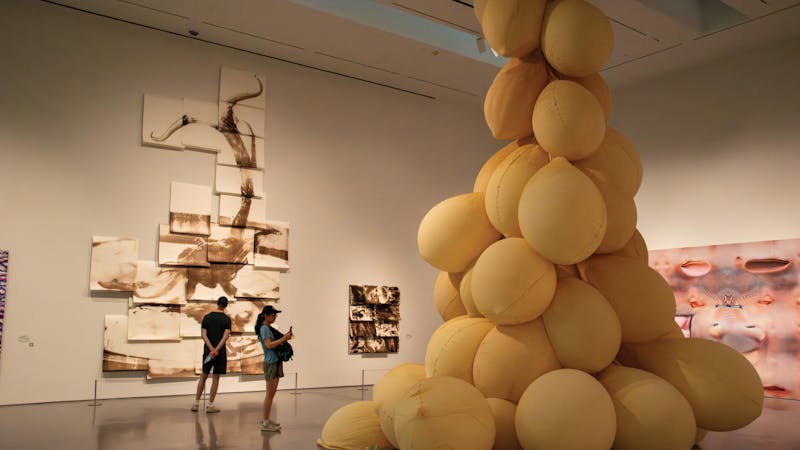KTRU interview: behind the genetic memory mystery with Matt Weston
I was driving with some friends recently when we suddenly heard a high-pitched screech punctuated by harsh thuds. "Do you hear that?" someone asked. "I think there might be a problem with the car." My friend laughed and pointed to the stereo, dialed to 91.7. "No, it's just KTRU."We were listening to a track from Matt Weston's album Not To Be Taken Away, released this past July on his label 7272music and currently in rotation on KTRU's playlist. Weston is a percussionist and electronic musician who is also a member of the experimental bands Barn Owl and Thrillpillow. This is his second full-length solo release after 2000's Vacuums.
Weston's work falls squarely in the category of what KTRU calls "genetic memory" and what most people call "really weird noise." Think crashing cymbals, crushing waves of feedback, the sound of wind in a metal scrapyard and buzzing robotic cicadas armed with power tools. Some listeners may find this sonic chaos headache-inducing, but for others it will provoke debate and discussion on the murky boundaries between music and noise. Here, Weston talks about the Recording Industry Association of America, the time 350 people walked out of his concert, a busted-up Volkswagen and more.
Rice Thresher: What draws you to music?
Matt Weston: What drew me initially was hearing The Beatles' Second Album when I was three. Discovering elements of that record in other music is what keeps me drawn to music. I could go on about how it's informed everything I've played and listened to since - everything from Merzbow to The Who to M.I.A. to Cecil Taylor to Pierre Henry. I highly recommend Dave Marsh's brilliant book about the record, also called The Beatles' Second Album.
Thresher: What advice would you give to first-time listeners of Not To Be Taken Away? Do you have any thoughts on how to navigate this experimental, nonmelodic landscape versus listening to a more conventional lyrical album?
MW: I'm not really sure; it depends on the listener. Some may find easy entrance points, and some may not. To be honest, as a listener, I'm not really good at making distinctions between melodic and nonmelodic, so I would be equally inept at articulating those distinctions. It's kind of like when someone asks me what kind of music I play, or to describe what it sounds like; I usually just respond by giving them a CD.
Thresher: For me at least, one productive way to experience your work and other experimental/minimalist music is by connecting it with other sensory modalities - visually and spatially, especially. For example, listening to "Yeah to Slang" gave me the image of a rusty metal hinge creaking back and forth, and thinking about that helped me "see" a kind of depth and texture to the music. . Do you connect sound with other senses?
MW: I suppose subconsciously I always do. I listened to Duke Ellington's work for years before I was able to really see the "colors " that he and others spoke of in his music. Once I did, it was a revelation. I was driving at the time and almost got in an accident.
Thresher: How much of your music is improvised?
MW: I hope this doesn't sound dismissive, because I definitely don't mean it to be, but what difference does it make? To paraphrase Cecil Taylor, the only thing that the listener knows about is the sounds that he or she hears.
Thresher: What other projects are you working on at the moment?
MW: I'm nearing completion of a three-movement work which entails multiple - sometimes up to 20 - overdubs of percussion, electronics and blowing into a cymbal placed on the surface of various drums, which produces an almost horn-like sound. That will hopefully be released in the fall. I'm also assembling a longer work for Absurd Records in Greece. That should hopefully be completed by the end of March, but I'm not sure of its release date. That one will incorporate multiple overdubs of stringed instruments (electric and acoustic) and electronics, as well as percussion.
Thresher: Where do you stand in the debate over music downloading, sampling and creative control? To what extent can someone claim ownership of a song?
MW: I believe sampling is a form of composition, but I also believe those whose work is sampled should be given co-writing credit. But that's a complicated issue, and one that dovetails into the downloading debate, in that musicians/composers aren't always - or even often - the owners of their own copyrighted material. The RIAA couldn't care less about artists' rights or the income of artists from copyrighted works. They're only worried about labels potentially losing profits - profits which, far more often than not, are the result of musicians being cheated out of royalties. The arguments against downloading ignore the fact that no correlation has been shown between illegal downloading and declining music sales - numerous studies done in the last 10 years bear that out - and ignore the myriad ways in which musicians and composers have been completely shafted by labels. Free downloading could never in a million years approach anything close to the damage that one-sided recording contracts have done to artists over the years.
Claiming ownership is tricky, in that, where samples are involved, it's easy to point to their use in a song; but when it's something like Queen quoting Chic's "Good Times" in "Another One Bites The Dust," that's seen as an homage, as a not-so-subtle wink, even though it's a note-for-note ripoff of Bernard Edwards' bassline. There's also instances like the hour-long version of "My Favorite Things " on John Coltrane's Live In Japan; it's credited to Rodgers and Hammerstein, despite the fact that very little of the music played in that hour can be directly attributed to them.
Thresher: Tell me about one band or musician that has you excited and that you think more people should be listening to.
MW: I don't think I can narrow it down to just one. Trumpeter-composer Bill Dixon has been making incredible music for 50 years, and in the last couple of years has produced some of his most intriguing and exciting work. My bandmates in Barn Owl, Chris Cooper and Andy Crespo, are geniuses. Chris put out two records last year, under his nom-de-tape-manipulation Angst Hase Pfeffer Nase, which are wall-to-wall solid brilliance. Andy's approach to the electric bass is completely unique and always stunning. I'm lucky to have them as bandmates.
Thresher: How are your live performances different from your recordings?
MW: Very little of what's on Not To Be Taken Away can be reproduced live, which was my intention. When I'm playing live, I use a setup that includes tympani, rototoms, various cymbals, electronics and various metal objects placed on the head of the tympani. The sonorities are definitely different from my studio recordings, but the phrasing and themes are similar.
Thresher: What was your most memorable performance?
MW: I was in a trio with bassist Mike Bullock and saxophonist David Gross, and we played for most of the student body of a small college. As with most shows, we didn't really know how we would be received, but it didn't really occur to us until right after we started. A lot of the students were shouting at us "You guys suck!" laughing and walking out. There were 400 people at the beginning and 50 at the end.
Thresher: What's the most joyful noise you've ever heard?
MW: Fortunately, that's something that changes from moment to moment: Clifford Brown's first solo on What Is This Thing Called Love; the 1986 VW Golf that we use in the auto salvage yard I work in, which is missing the catalytic converter; Iannis Xenakis' "S.709"; the Beatles' "She Loves You"; Jerry Lewis screaming and shouting; Public Enemy's "Brothers Gonna Work It Out"; and the frantic flurry that Keith Moon closes out a live version of The Who's "Bargain" with.

More from The Rice Thresher

Rice loses to UH in Bayou Bucket Classic
The Bayou Bucket will remain with the University of Houston until at least 2030 after Rice football lost to the Cougars Saturday.

Moody Center’s new exhibit blurs the line between body and machine
Swelling latex sculptures, inspired by placentas and umbilical cords have taken up residence in the Moody Center for the Arts. The Barcelona-based artist Eva Fàbregas describes her pieces as forms that grow from “the guts of the architecture,” inflating and wrinkling as if they were alive.

Fizz users and moderators talk fame, challenges
During the volleyball team’s face-off against the University of Texas at Austin on Sept. 3, Jack Vu decided to have a little fun with the scoreboard. An anonymous poster had inaccurately mentioned that Rice beat UT on Fizz, so Vu decided to join in.

Please note All comments are eligible for publication by The Rice Thresher.